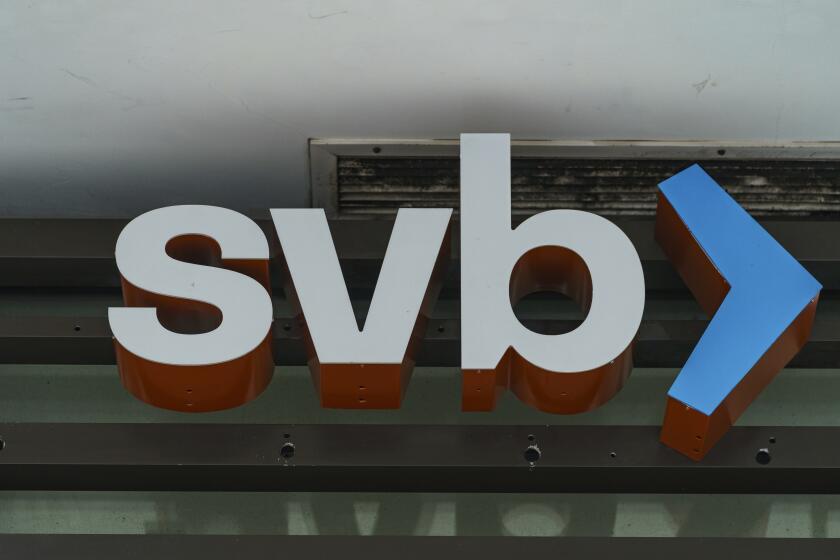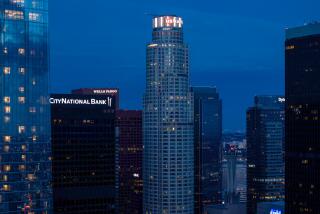First Republic: Cheap, interest-only jumbo mortgages to Silicon Valley’s elite fueled the bank’s failure

- Share via
The seeds of First Republic Bank’s downfall were sown in the jumbo mortgages of Silicon Valley, where a unique strategy to loan wealthy individuals extraordinary sums of money blew up in spectacular fashion.
In the early 1980s, First Republic Chairman Jim Herbert, then running San Francisco Bancorp, wanted to get into a new line of business. The Bay Area’s high earners were coming to him and asking for unusually large loans to buy pricey properties in the area.
“Why don’t we do a couple of these and see how they go? Can’t bankrupt the whole bank,” Herbert said to the firm’s president, according to an account of the conversation on First Republic’s website.
Years later, after Herbert left San Francisco Bancorp and founded First Republic, his new bank became known for handing out interest-only mortgages at rock-bottom rates to borrowers with high incomes and exceptional credit scores. Typically, they didn’t have to start repaying the principal for a decade.
Demand for the loans surged during the pandemic as wealthy buyers sought mortgage deals that would allow them to keep the bulk of their money in higher return investments. The rush helped First Republic double its assets in four years. It also contributed to its collapse.
The Federal Deposit Insurance Corp. says JPMorgan Chase Bank will take over all assets of troubled First Republic Bank.
In the early hours of Monday morning, JPMorgan Chase & Co. agreed to acquire First Republic from the Federal Deposit Insurance Corp., which seized the bank after a tumultuous period in which its stock had cratered and depositors had pulled almost half their money. Just a few weeks earlier, Wall Street’s biggest banks had stepped in to shore it up with their own cash.
The deal marks the second-biggest bank failure ever in the United States and the third this year alone, bringing March’s banking crisis back into focus after a relative lull in the weeks since Silicon Valley Bank and Signature Bank went under.
This account is based on conversations with multiple people familiar with the last few weeks, all of whom asked not to be identified discussing private information.
Rescue plan
It wasn’t supposed to play out this way.
On March 16, as panic spread across regional banks in the U.S., 11 of the country’s biggest lenders banded together to inject $30 billion of deposits into First Republic for at least four months. The bank’s stock price had cratered in the week since Silicon Valley Bank and Signature had collapsed, with investors concerned that First Republic’s large proportion of uninsured deposits could leave it vulnerable to the same fate. The cash dump was supposed to stabilize the bank, buying it enough time to find an acquirer and avoid being seized by regulators.
First Republic’s mergers and acquisitions advisors quickly got to work trying to persuade those same banks to go all in on a full acquisition of the lender. Leading the charge was Peter Orszag, Lazard’s head of financial advisory and once a top economist to President Obama. He’d been brought in alongside longtime advisors from JPMorgan in case a conflict arose if the latter decided to make a bid; the bank’s chief executive officer, Jamie Dimon, had helped orchestrate the deposit deal, after all.
Dimon played down his role in the initial rescue deal on a conference call Monday, saying he was “just the first phone call.” He added that the system for keeping the advisory team separate from those considering a purchase had been “very, very sound.”
At the center of First Republic’s balance sheet was a $137-billion problem that made it a particularly hard sell: a giant book of those low-interest mortgages, mixed with some others, whose value had been severely dented since the Federal Reserve started raising interest rates.
At the start of the year, First Republic said its mortgages would be worth about $19 billion less than face value if sold off. It also had another $8 billion or so in markdowns on other loans as well as unrealized losses on bonds.
Potential bidders quickly realized that, in a sale, those $27 billion in unrealized losses would completely wipe out the firm’s $13 billion in tangible common equity. Analysts began speculating that even at $0 a share, no one would bite. Despite Orszag’s best efforts, First Republic seemed doomed to muddle along in a zombie-like state.
Days before First Republic was set to report first-quarter earnings, U.S. regulators turned up the heat. They reached out to some industry leaders to encourage a renewed push to find a private solution and warned the lenders to prepare in case something happened soon, according to people with knowledge of the discussions. But the weekend passed without any news, and the banks held firm.
The moves to tighten rules on midsize institutions come as the Biden administration searches for tools to further calm the banking crisis and prevent another failure.
Then, earnings day came and everything changed. After several of its fellow regional lenders surprised investors with better-than-expected presentations, First Republic’s post-market update on April 24 confirmed their worst fears. Deposits had plunged by $70 billion — almost half the bank’s total — in a matter of weeks as customers yanked their money while the crisis was playing out. Its stock price, already down 87% this year, went into yet another freefall.
As the bank’s executives sped through a 12-minute conference call and refused to take questions, Orszag and his team — still pitching hard — were having a tough time persuading any of First Republic’s earlier saviors to step up a second time. The FDIC, advised by a Guggenheim Securities team led by former Treasury restructuring chief Jim Millstein, and mindful of how long it had taken to find a buyer for Silicon Valley Bank, was already making plans for what would happen next.
For its part, the Treasury Department, which would have been responsible for bringing the banking industry together in a second rescue plan, deferred to the smaller financial regulator throughout, the people said.
Why make a deal now, the banks reasoned, when if they waited a few days they could probably buy the bank directly from the FDIC with better terms? That put them at an impasse with the agency, which was desperate to avoid the losses to its deposit insurance fund that would be inevitable if it seized the firm. For days, the game of cat-and-mouse played on.
Part of the problem was that any viable way to shore up First Republic that its advisors pitched, including buying just their underwater bonds at full value or taking an equity stake in the company, would only set the stage for a competitor to later get a sweeter deal for the entire bank. Meanwhile, First Republic’s wealth managers were jumping ship for rivals, damaging its most lucrative franchise.
In the end, the FDIC blinked first, asking banks late last week to outline what they’d pay and, crucially, how much it would cost the agency’s fund. Final offers were due noon on Sunday but deliberations dragged late into the night, frustrating the giant teams that each bidder had put together to run the deals.
The compensation structure for the industry has for too long rewarded taking on too much risk.
Dimon said Monday that hundreds of people worked around the clock on the bank’s winning bid, which was the only proposal that offered to take the entire bank off the FDIC’s hands, according to people familiar with the details.
JPMorgan now owns about $173 billion of First Republic’s loans, $30 billion of securities and $92 billion in deposits. It will share any losses on the firm’s single-family and commercial loans with the FDIC, and repay the deposits that the other banks put up in March.
“This is actually a very good outcome for everyone,” Dimon said Monday. “This is how the system is meant to work.”
Open houses
For First Republic’s Herbert, the sale brings to an end the 40-odd years he’d spent building the bank, from a single branch in San Francisco’s financial district to 93 offices across the U.S. with total assets of more than $200 billion. JPMorgan said Monday it won’t keep the First Republic name, and will rebrand some of its existing wealth centers.
In the early days, Herbert trawled open houses across San Francisco, networking with brokers who could pitch the bank’s jumbo mortgages to their clients. Over the next couple of decades, First Republic weathered the savings and loan crisis of the mid-1980s, went public on the Nasdaq and expanded into wealth management — and New York — with the acquisition of Trainer Wortham, a storied investment firm with an office in Midtown Manhattan.
In 2007, months before the global financial crisis started to engulf the world’s banks, Merrill Lynch paid $1.8 billion to buy First Republic. The acquisition was a bet that the bank’s wealthy mortgage customers would move the bulk of their money into Merrill Lynch and pay for its brokerage services.
Critics of the government response to the Silicon Valley Bank collapse say it’s a taxpayer-funded bailout. They’re wrong.
Barely 18 months later, Bank of America swallowed Merrill Lynch and its First Republic subsidiary as Wall Street imploded around it. Less than a year after that, First Republic was back in Herbert’s hands as part of a management buyout backed by General Atlantic and Tom Barrack’s Colony Capital.
“There is nothing that cements a culture more than a successful challenge that the team overcomes as a group,” Herbert said at the time.
In some ways, the resolution was a win for the FDIC. Unlike the drawn-out, multi-week effort to shift Silicon Valley Bank off its books, the deal was done and dusted in a weekend, just as the regulator prefers.
But it leaves bigger questions for the banking industry at large; namely, can a private solution for a flailing bank, as the JPMorgan-led group attempted in mid-March, ever really work? As one senior executive at a bank that contributed money to the effort said: It certainly couldn’t be done more than once.
“This is another one-off solution to the liquidity crisis,” James Fotheringham and Rufus Hone of BMO Capital Markets wrote in a note Monday. “We worry the market will find another target for funding concerns.”
More to Read
Inside the business of entertainment
The Wide Shot brings you news, analysis and insights on everything from streaming wars to production — and what it all means for the future.
You may occasionally receive promotional content from the Los Angeles Times.














